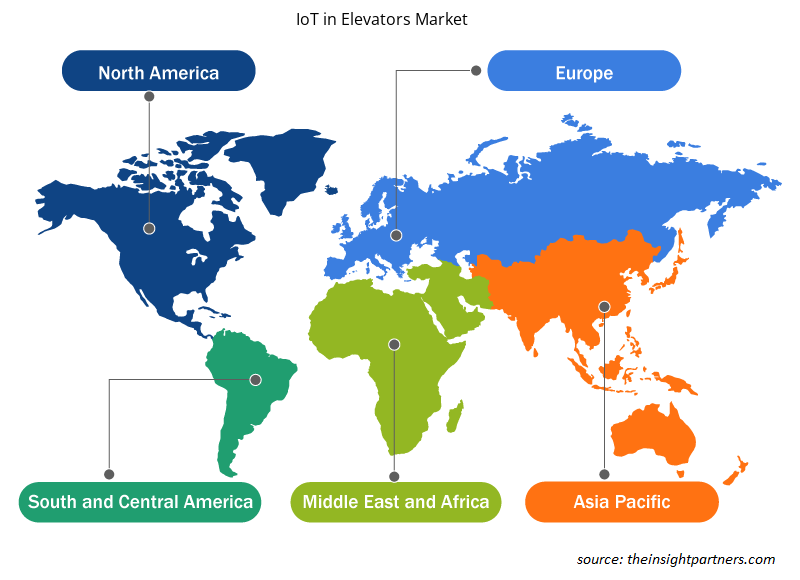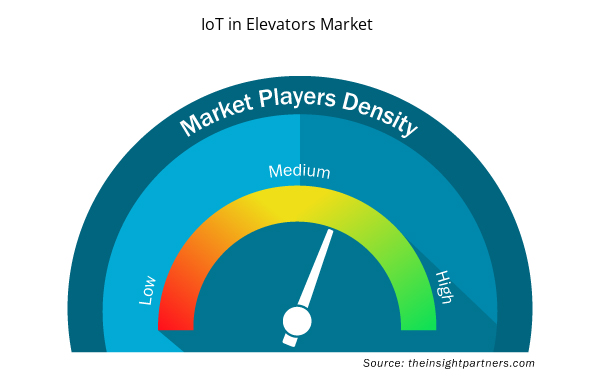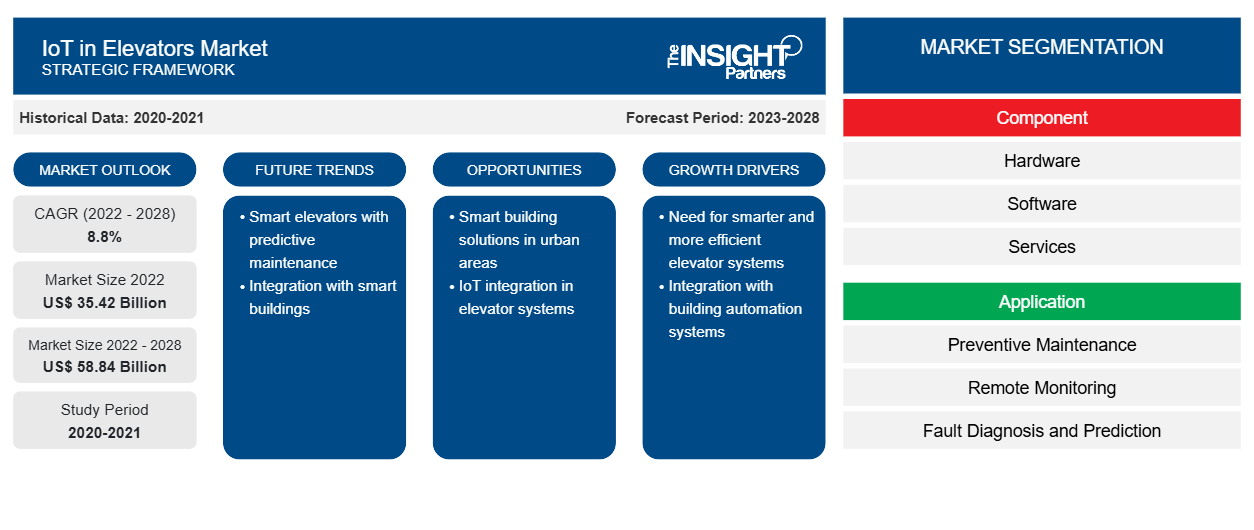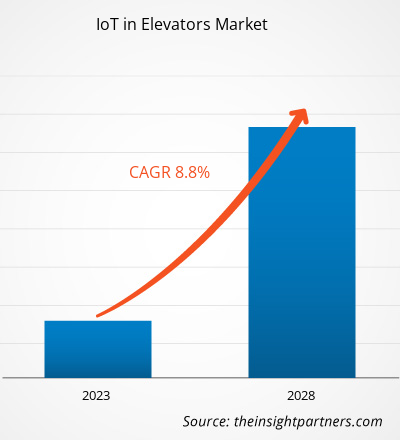[Rapporto di ricerca] Si prevede che il mercato dell'IoT negli ascensori crescerà da 35.415,87 milioni di dollari nel 2022 a 58.843,69 milioni di dollari entro il 2028; si prevede che crescerà a un CAGR dell'8,8% dal 2022 al 2028.
Le piccole e medie imprese (PMI) e le grandi imprese fanno molto affidamento su soluzioni intelligenti. L'adozione dell'IoT in queste imprese sta diventando popolare, il che guida la crescita del mercato dell'IoT negli ascensori . Inoltre, con la crescente concorrenza, molte imprese stanno investendo in modo significativo in soluzioni e servizi intelligenti. Pertanto, ci sono opportunità redditizie per i principali fornitori di IoT negli ascensori poiché queste imprese hanno sempre più fatto affidamento sulla salvaguardia e la protezione delle loro proprietà da minacce interne o esterne. Molti governi stanno anche investendo in progetti di sviluppo urbano. Secondo il Ministero dell'edilizia abitativa e degli affari urbani, il governo indiano ha investito 160 miliardi di dollari USA nello sviluppo e nell'ammodernamento delle infrastrutture urbane dal 2014. Rispetto al 2004-2014, gli investimenti dell'India nel settore urbano sono aumentati di oltre il 600% dal 2014 al 2021. Il governo indiano ha istituito una National Infrastructure Pipeline (NIP) del valore di 1,5 trilioni di dollari USA per progetti infrastrutturali che dovrebbero essere completati tra il 2020 e il 2025.
Politiche favorevoli, iniziative e massicci investimenti in città intelligenti e progetti di sviluppo urbano da parte di organizzazioni governative e private hanno creato opportunità redditizie per i principali attori che operano nel mercato dell'IoT negli ascensori. Inoltre, durante il periodo di previsione, si prevede che l'espansione delle economie e il crescente interesse nello sviluppo di verticali industriali leader aumenteranno la domanda di IoT negli ascensori. Tuttavia, gli elevati investimenti iniziali necessari nella modernizzazione degli ascensori e nelle integrazioni IoT limitano la crescita del mercato dell'IoT negli ascensori.
Personalizza questo report in base alle tue esigenze
Riceverai la personalizzazione gratuita di qualsiasi report, comprese parti di questo report, o analisi a livello nazionale, pacchetto dati Excel, oltre a usufruire di grandi offerte e sconti per start-up e università
- Scopri le principali tendenze di mercato in questo rapporto.Questo campione GRATUITO includerà analisi di dati che spaziano dalle tendenze di mercato alle stime e alle previsioni.
Impatto della pandemia di COVID-19 sulla crescita del mercato europeo dell'IoT negli ascensori
La pandemia di COVID-19 ha avuto un impatto grave sui paesi europei, tra cui Germania, Francia, Spagna e Italia. L'Italia è stata il paese più colpito durante il periodo post-pandemia. Prima della pandemia, si prevedeva che il mercato dell'IoT negli ascensori sarebbe aumentato in modo significativo a causa della crescente domanda di prodotti e servizi a risparmio energetico; della crescente adozione di piattaforme basate su IoT, soluzioni basate su cloud e AI; e della crescente domanda di industrializzazione in ogni settore verticale industriale.
L'industria elettronica è tra i settori più colpiti in alcuni paesi d'Europa. Tuttavia, nella seconda ondata dell'epidemia di COVID-19, il settore dell'elettronica e dei semiconduttori è stato influenzato negativamente dalla pandemia. Nel 2021, con l'allentamento delle misure di blocco, l'attività manifatturiera è ripartita. Quindi, le prospettive per l'IoT nel mercato degli ascensori hanno acquisito slancio. Inoltre, nel 2022, si prevede che la domanda di IoT crescerà a causa della crescente costruzione di edifici commerciali e industriali. Quindi, l'IoT nel business degli ascensori ha beneficiato della pandemia. Nello scenario post-pandemia, l'adozione dell'IoT per la sostenibilità, il passaggio alle piattaforme cloud, la crescente agevolazione fiscale per i cittadini e vari settori industriali verticali e l'accesso remoto protetto rafforzerebbero l'espansione dell'IoT nel mercato degli ascensori.
Approfondimenti di mercato – IoT nel mercato degli ascensori
Il mercato globale dell'IoT negli ascensori è suddiviso in Nord America, Europa, Asia-Pacifico (APAC), Medio Oriente e Africa (MEA) e Sud America (SAM) in base alla regione.
L'Europa ha detenuto la quota di mercato più grande dell'IoT negli ascensori nel 2021 e si prevede che dominerà il mercato anche durante il periodo di previsione. L'adozione del 5G e gli investimenti delle aziende nel miglioramento dell'infrastruttura 5G guidano la crescita del mercato nella regione. La Germania ha una lunga storia di investimenti e innovazione nell'IoT industriale nel corso degli anni. Il paese è anche leader nell'uso del 5G per espandere l'uso dell'IoT industriale. La crescente domanda di sistemi di imaging industriale nel settore manifatturiero industriale e di componenti avanzati di infotainment automobilistico, dispositivi di monitoraggio del conducente e unità di controllo del conducente dai settori automobilistici influenzano ulteriormente la domanda di IoT negli ascensori dai settori manifatturiero e automobilistico. Anche la rapida crescita delle costruzioni nel settore commerciale in tutto il paese sta aumentando la domanda di sistemi di ascensori basati su IoT. Questi fattori stanno stimolando la crescita dell'IoT nel mercato degli ascensori in Europa.
Il Nord America ha detenuto la seconda quota più grande del mercato IoT negli ascensori nel 2020. Si prevede che il mercato negli Stati Uniti manterrà le sue solide prospettive di crescita durante il periodo di previsione. Negli Stati Uniti, l'aumento del reddito disponibile e il miglioramento dello standard di vita spingono la domanda di elettronica intelligente. La domanda di dispositivi in miniatura è elevata a causa della crescente popolarità dell'intelligenza artificiale e della rivoluzione industriale 4.0. Inoltre, molti produttori stanno investendo ingenti capitali nello sviluppo di sistemi di digitalizzazione dell'elettronica intelligente, come per le applicazioni di automazione delle infrastrutture. Il governo degli Stati Uniti ha preso molte iniziative per dare impulso all'industria elettronica. Il 6 maggio 2022, il governo ha proposto una nuova proposta bipartisan negli Stati Uniti per alimentare il settore dei circuiti stampati (PCB) del paese. Molte aziende affermate del settore della produzione di elettronica nel paese hanno accolto con favore la proposta. Il disegno di legge sosterrà il CHIPS Act del 2021 e l'American Printed Circuit Boards Act del 2022. Di conseguenza, ci sono molte opportunità redditizie per le principali aziende operanti nel mercato IoT negli ascensori.
Approfondimenti basati sui componenti
In base ai componenti, il mercato IoT negli ascensori è segmentato in hardware, software e servizi. Il segmento hardware ha rappresentato il mercato più grande nel 2021. La domanda di hardware è aumentata drasticamente negli ultimi anni. L'intelligenza artificiale viene utilizzata per aiutare gli operatori e gli appaltatori meccanici a tenere il passo con le loro routine quotidiane e trovare modi per gestire il traffico degli ascensori e prevenire i problemi prima che si verifichino, in base ai dati raccolti dall'utilizzo quotidiano degli ascensori.
In base all'applicazione, il mercato IoT negli ascensori è segmentato in manutenzione preventiva, monitoraggio remoto, diagnosi e previsione dei guasti, reporting avanzato e gestione della connettività. Il mercato IoT negli ascensori, in base all'utente finale, è segmentato in residenziale, commerciale e industriale. In base alla geografia, il mercato è principalmente segmentato in Nord America, Europa, Asia Pacifico (APAC), Medio Oriente e Africa (MEA) e Sud America.
OTIS; Schindler Group; KONE Corporation; Hyundai Elevator Co., Ltd.; e Fujitec sono tra i principali attori del mercato IoT negli ascensori. Il mercato è altamente frammentato con diversi attori localizzati in una regione specifica per soddisfare la domanda interna.
Approfondimenti regionali sul mercato IoT degli ascensori
Le tendenze regionali e i fattori che influenzano l'IoT nel mercato degli ascensori durante il periodo di previsione sono stati ampiamente spiegati dagli analisti di Insight Partners. Questa sezione discute anche i segmenti e la geografia dell'IoT nel mercato degli ascensori in Nord America, Europa, Asia Pacifico, Medio Oriente e Africa e America meridionale e centrale.

- Ottieni i dati specifici regionali per l'IoT nel mercato degli ascensori
Ambito del rapporto di mercato IoT negli ascensori
| Attributo del report | Dettagli |
|---|---|
| Dimensioni del mercato nel 2022 | 35,42 miliardi di dollari USA |
| Dimensioni del mercato entro il 2028 | 58,84 miliardi di dollari USA |
| CAGR globale (2022 - 2028) | 8,8% |
| Dati storici | 2020-2021 |
| Periodo di previsione | 2023-2028 |
| Segmenti coperti | Per componente
|
| Regioni e Paesi coperti | America del Nord
|
| Leader di mercato e profili aziendali chiave |
|
Densità degli attori del mercato: comprendere il suo impatto sulle dinamiche aziendali
Il mercato IoT in Elevators Market sta crescendo rapidamente, spinto dalla crescente domanda degli utenti finali dovuta a fattori quali l'evoluzione delle preferenze dei consumatori, i progressi tecnologici e una maggiore consapevolezza dei vantaggi del prodotto. Con l'aumento della domanda, le aziende stanno ampliando le loro offerte, innovando per soddisfare le esigenze dei consumatori e capitalizzando sulle tendenze emergenti, il che alimenta ulteriormente la crescita del mercato.
La densità degli operatori di mercato si riferisce alla distribuzione di aziende o società che operano in un particolare mercato o settore. Indica quanti concorrenti (operatori di mercato) sono presenti in un dato spazio di mercato in relazione alle sue dimensioni o al valore di mercato totale.
Le principali aziende che operano nel mercato IoT negli ascensori sono:
- Azienda Fujitec Co., Ltd.
- Hitachi, Ltd.
- Società KONE
- Mitsubishi Electric Corporation
- Azienda Otis Elevator Ltd.
Disclaimer : le aziende elencate sopra non sono classificate secondo un ordine particolare.

- Ottieni la panoramica dei principali attori del mercato IoT negli ascensori
Gli operatori che operano nell'analisi del mercato dell'IoT negli ascensori si concentrano principalmente sullo sviluppo di prodotti avanzati ed efficienti.
- A dicembre 2021, KONE, un produttore multinazionale di ascensori e scale mobili, ha stretto una partnership con Amazon Web Services (AWS), la piattaforma cloud più completa e ampiamente utilizzata al mondo. AWS fornirà funzionalità cloud in tutto il mondo a KONE, tra cui Internet of Things (IoT) e analisi. Inoltre, le aziende collaboreranno per creare nuove tecnologie che miglioreranno la scalabilità e le prestazioni dei servizi e delle soluzioni connesse di KONE.
- Nell'aprile 2021, Mitsubishi Electric Corporation ha annunciato che la sua controllata Mitsubishi Elevator India Private Limited (IMEC) ha ricevuto un contratto firmato per la fornitura di ascensori ai complessi di lusso Commerzone Madhapur e Altimus, di proprietà di K RAHEJA CORP, un rinomato costruttore indiano.
- Analisi storica (2 anni), anno base, previsione (7 anni) con CAGR
- Analisi PEST e SWOT
- Valore/volume delle dimensioni del mercato - Globale, regionale, nazionale
- Industria e panorama competitivo
- Set di dati Excel



Report Coverage
Revenue forecast, Company Analysis, Industry landscape, Growth factors, and Trends

Segment Covered
This text is related
to segments covered.

Regional Scope
North America, Europe, Asia Pacific, Middle East & Africa, South & Central America

Country Scope
This text is related
to country scope.
Domande frequenti
IoT in elevator company expansion and initiatives taken by these companies for developments in IoT in an elevator are supporting the market growth. Moreover, rising trends toward energy-efficient products & services are further supporting the growth of IoT in elevators market.
Residential is the leading end-user segment in the IoT in elevators market. With increasing projects in residential sector, will help in boosting the demand for advanced elevators.
The IoT in elevators market is estimated to grow at US$ 58,843.69 Million by 2028 at a CAGR of 8.8% during the forecast period.
Europe is holding major market share of IoT in elevators market.
OTIS, Schindler Group, Fujitec Co., Ltd., Hitachi, Ltd, Ltd., and KONE Corporation are the five key players holding the major market share in the IoT in elevators market.
The IoT in elevators market is primarily driven by the integration of elevator systems with smart technologies and the rise in the number of construction projects in urban areas across the world. Elevator's functions have changed significantly over the last decade owing to the advances in IoT and AI.
Trends and growth analysis reports related to Electronics and Semiconductor : READ MORE..
The List of Companies - IoT in Elevator Market
- Fujitec Co., Ltd.
- Hitachi, Ltd.
- KONE Corporation
- Mitsubishi Electric Corporation
- Otis Elevator Company Ltd.
- Bosch GmbH
- Schindler Group
- Schneider Electric SE
- Toshiba Elevators and Building Systems Corporation
- Hyundai Elevator Co., Ltd.
The Insight Partners performs research in 4 major stages: Data Collection & Secondary Research, Primary Research, Data Analysis and Data Triangulation & Final Review.
- Data Collection and Secondary Research:
As a market research and consulting firm operating from a decade, we have published and advised several client across the globe. First step for any study will start with an assessment of currently available data and insights from existing reports. Further, historical and current market information is collected from Investor Presentations, Annual Reports, SEC Filings, etc., and other information related to company’s performance and market positioning are gathered from Paid Databases (Factiva, Hoovers, and Reuters) and various other publications available in public domain.
Several associations trade associates, technical forums, institutes, societies and organization are accessed to gain technical as well as market related insights through their publications such as research papers, blogs and press releases related to the studies are referred to get cues about the market. Further, white papers, journals, magazines, and other news articles published in last 3 years are scrutinized and analyzed to understand the current market trends.
- Primary Research:
The primarily interview analysis comprise of data obtained from industry participants interview and answers to survey questions gathered by in-house primary team.
For primary research, interviews are conducted with industry experts/CEOs/Marketing Managers/VPs/Subject Matter Experts from both demand and supply side to get a 360-degree view of the market. The primary team conducts several interviews based on the complexity of the markets to understand the various market trends and dynamics which makes research more credible and precise.
A typical research interview fulfils the following functions:
- Provides first-hand information on the market size, market trends, growth trends, competitive landscape, and outlook
- Validates and strengthens in-house secondary research findings
- Develops the analysis team’s expertise and market understanding
Primary research involves email interactions and telephone interviews for each market, category, segment, and sub-segment across geographies. The participants who typically take part in such a process include, but are not limited to:
- Industry participants: VPs, business development managers, market intelligence managers and national sales managers
- Outside experts: Valuation experts, research analysts and key opinion leaders specializing in the electronics and semiconductor industry.
Below is the breakup of our primary respondents by company, designation, and region:

Once we receive the confirmation from primary research sources or primary respondents, we finalize the base year market estimation and forecast the data as per the macroeconomic and microeconomic factors assessed during data collection.
- Data Analysis:
Once data is validated through both secondary as well as primary respondents, we finalize the market estimations by hypothesis formulation and factor analysis at regional and country level.
- Macro-Economic Factor Analysis:
We analyse macroeconomic indicators such the gross domestic product (GDP), increase in the demand for goods and services across industries, technological advancement, regional economic growth, governmental policies, the influence of COVID-19, PEST analysis, and other aspects. This analysis aids in setting benchmarks for various nations/regions and approximating market splits. Additionally, the general trend of the aforementioned components aid in determining the market's development possibilities.
- Country Level Data:
Various factors that are especially aligned to the country are taken into account to determine the market size for a certain area and country, including the presence of vendors, such as headquarters and offices, the country's GDP, demand patterns, and industry growth. To comprehend the market dynamics for the nation, a number of growth variables, inhibitors, application areas, and current market trends are researched. The aforementioned elements aid in determining the country's overall market's growth potential.
- Company Profile:
The “Table of Contents” is formulated by listing and analyzing more than 25 - 30 companies operating in the market ecosystem across geographies. However, we profile only 10 companies as a standard practice in our syndicate reports. These 10 companies comprise leading, emerging, and regional players. Nonetheless, our analysis is not restricted to the 10 listed companies, we also analyze other companies present in the market to develop a holistic view and understand the prevailing trends. The “Company Profiles” section in the report covers key facts, business description, products & services, financial information, SWOT analysis, and key developments. The financial information presented is extracted from the annual reports and official documents of the publicly listed companies. Upon collecting the information for the sections of respective companies, we verify them via various primary sources and then compile the data in respective company profiles. The company level information helps us in deriving the base number as well as in forecasting the market size.
- Developing Base Number:
Aggregation of sales statistics (2020-2022) and macro-economic factor, and other secondary and primary research insights are utilized to arrive at base number and related market shares for 2022. The data gaps are identified in this step and relevant market data is analyzed, collected from paid primary interviews or databases. On finalizing the base year market size, forecasts are developed on the basis of macro-economic, industry and market growth factors and company level analysis.
- Data Triangulation and Final Review:
The market findings and base year market size calculations are validated from supply as well as demand side. Demand side validations are based on macro-economic factor analysis and benchmarks for respective regions and countries. In case of supply side validations, revenues of major companies are estimated (in case not available) based on industry benchmark, approximate number of employees, product portfolio, and primary interviews revenues are gathered. Further revenue from target product/service segment is assessed to avoid overshooting of market statistics. In case of heavy deviations between supply and demand side values, all thes steps are repeated to achieve synchronization.
We follow an iterative model, wherein we share our research findings with Subject Matter Experts (SME’s) and Key Opinion Leaders (KOLs) until consensus view of the market is not formulated – this model negates any drastic deviation in the opinions of experts. Only validated and universally acceptable research findings are quoted in our reports.
We have important check points that we use to validate our research findings – which we call – data triangulation, where we validate the information, we generate from secondary sources with primary interviews and then we re-validate with our internal data bases and Subject matter experts. This comprehensive model enables us to deliver high quality, reliable data in shortest possible time.


 Ottieni un campione gratuito per questo repot
Ottieni un campione gratuito per questo repot